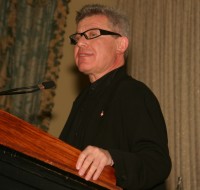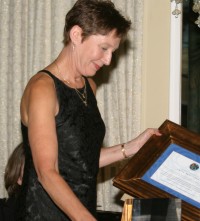
Daniel Libeskind
| 
Lolle Boettcher | GHETTO FIGHTERS MUSEUM
Living The Memory
With A Master Planner By Nina Boxer  HERE was Daniel Libeskind on 9/11? America’s most famous architect in the rebuilding of Ground Zero had completed one of his “living memory constructions” – the Jewish Museum of Berlin – and it had its grand opening on Sept. 11, 2001. HERE was Daniel Libeskind on 9/11? America’s most famous architect in the rebuilding of Ground Zero had completed one of his “living memory constructions” – the Jewish Museum of Berlin – and it had its grand opening on Sept. 11, 2001.
“It closed two hours after it opened,” he said, “because of the uncertainty as to what the world was coming to.” As Libeskind accepted the Janusz Korczak Honorary Award from the American Friends of the Ghetto Fighters’ Museum in Israel, he was reminded of the time his mother, as a teenager in Lodz, Poland, won first prize in a writing competition judged by Janusz Korczak, the famous children’s educator. The dinner at the Pierre Hotel also honored the Moriah School in Englewood , N.J. , and Lolle Boettcher, a Christian schoolteacher in St. Louis , Missouri . The evening raised $1.4 million for the museum in Kibbutz Beit Lohamei Haghetaot in the western Galilee . “The history of the Holocaust then is a topic that I feel compelled to teach,” Boettcher said. “It has caused me to look at life through this event and has reshaped all I believe.” “Many think architecture is simply an act of construction,” Libeskind said, “but it is also an act of living memory and a communicative act.” For the Jewish Museum in Berlin he didn’t create just “a container with windows.” He explained, “The building is penetrated by a life that comes from really no-longer-visible addresses of Jews and Germans who lived around the site. These slashes and wounds in the building communicate that we are still in touch with those things that are not completely visible or audible to us.” |